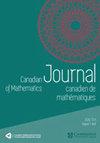Application of capacities to space–time fractional dissipative equations I: regularity and the blow-up set
IF 0.7
3区 数学
Q3 MATHEMATICS
Canadian Journal of Mathematics-Journal Canadien De Mathematiques
Pub Date : 2022-10-25
DOI:10.4153/s0008414x22000566
引用次数: 0
Abstract
Abstract We apply capacities to explore the space–time fractional dissipative equation: (0.1) $$ \begin{align} \left\{\begin{aligned} &\partial^{\beta}_{t}u(t,x)=-\nu(-\Delta)^{\alpha/2}u(t,x)+f(t,x),\quad (t,x)\in\mathbb R^{1+n}_{+},\\ &u(0,x)=\varphi(x),\ x\in\mathbb R^{n}, \end{aligned}\right. \end{align} $$ where $\alpha>n$ and $\beta \in (0,1)$ . In this paper, we focus on the regularity and the blow-up set of mild solutions to (0.1). First, we establish the Strichartz-type estimates for the homogeneous term $R_{\alpha ,\beta }(\varphi )$ and inhomogeneous term $G_{\alpha ,\beta }(g)$ , respectively. Second, we obtain some space–time estimates for $G_{\alpha ,\beta }(g).$ Based on these estimates, we prove that the continuity of $R_{\alpha ,\beta }(\varphi )(t,x)$ and the Hölder continuity of $G_{\alpha ,\beta }(g)(t,x)$ on $\mathbb {R}^{1+n}_+,$ which implies a Moser–Trudinger-type estimate for $G_{\alpha ,\beta }.$ Then, for a newly introduced $L^{q}_{t}L^p_{x}$ -capacity related to the space–time fractional dissipative operator $\partial ^{\beta }_{t}+(-\Delta )^{\alpha /2},$ we perform the geometric-measure-theoretic analysis and establish its basic properties. Especially, we estimate the capacity of fractional parabolic balls in $\mathbb {R}^{1+n}_+$ by using the Strichartz estimates and the Moser–Trudinger-type estimate for $G_{\alpha ,\beta }.$ A strong-type estimate of the $L^{q}_{t}L^p_{x}$ -capacity and an embedding of Lorentz spaces are also derived. Based on these results, especially the Strichartz-type estimates and the $L^{q}_{t}L^p_{x}$ -capacity of fractional parabolic balls, we deduce the size, i.e., the Hausdorff dimension, of the blow-up set of solutions to (0.1).容量在时空分数阶耗散方程中的应用I:正则性与爆破集
摘要:我们利用容量来探索时空分数耗散方程:(0.1)$$ \begin{align} \left\{\begin{aligned} &\partial^{\beta}_{t}u(t,x)=-\nu(-\Delta)^{\alpha/2}u(t,x)+f(t,x),\quad (t,x)\in\mathbb R^{1+n}_{+},\\ &u(0,x)=\varphi(x),\ x\in\mathbb R^{n}, \end{aligned}\right. \end{align} $$其中$\alpha>n$和$\beta \in (0,1)$。本文主要讨论了(0.1)的正则性和温和解的爆破集。首先,我们分别建立了齐次项$R_{\alpha ,\beta }(\varphi )$和非齐次项$G_{\alpha ,\beta }(g)$的strichartz型估计。其次,我们得到了$G_{\alpha ,\beta }(g).$的一些时空估计,在这些估计的基础上,我们证明了$R_{\alpha ,\beta }(\varphi )(t,x)$的连续性和$G_{\alpha ,\beta }(g)(t,x)$在$\mathbb {R}^{1+n}_+,$上的Hölder连续性,这意味着$G_{\alpha ,\beta }.$的moser - trudinger型估计。然后,我们对一个新引入的与时空分数阶耗散算子$\partial ^{\beta }_{t}+(-\Delta )^{\alpha /2},$相关的$L^{q}_{t}L^p_{x}$ -容量进行了几何测量理论分析,并建立了它的基本性质。特别地,我们利用$G_{\alpha ,\beta }.$的Strichartz估计和moser - trudinger型估计估计了$\mathbb {R}^{1+n}_+$中分数抛物球的容量,并推导了$L^{q}_{t}L^p_{x}$ -容量的强型估计和Lorentz空间的嵌入。根据这些结果,特别是strichartz型估计和分数抛物线球的$L^{q}_{t}L^p_{x}$ -容量,我们推导出(0.1)的爆破解集的大小,即Hausdorff维数。
本文章由计算机程序翻译,如有差异,请以英文原文为准。
求助全文
约1分钟内获得全文
求助全文
来源期刊
CiteScore
1.80
自引率
0.00%
发文量
58
审稿时长
4.5 months
期刊介绍:
The Canadian Journal of Mathematics (CJM) publishes original, high-quality research papers in all branches of mathematics. The Journal is a flagship publication of the Canadian Mathematical Society and has been published continuously since 1949. New research papers are published continuously online and collated into print issues six times each year.
To be submitted to the Journal, papers should be at least 18 pages long and may be written in English or in French. Shorter papers should be submitted to the Canadian Mathematical Bulletin.
Le Journal canadien de mathématiques (JCM) publie des articles de recherche innovants de grande qualité dans toutes les branches des mathématiques. Publication phare de la Société mathématique du Canada, il est publié en continu depuis 1949. En ligne, la revue propose constamment de nouveaux articles de recherche, puis les réunit dans des numéros imprimés six fois par année.
Les textes présentés au JCM doivent compter au moins 18 pages et être rédigés en anglais ou en français. C’est le Bulletin canadien de mathématiques qui reçoit les articles plus courts.

 求助内容:
求助内容: 应助结果提醒方式:
应助结果提醒方式:


